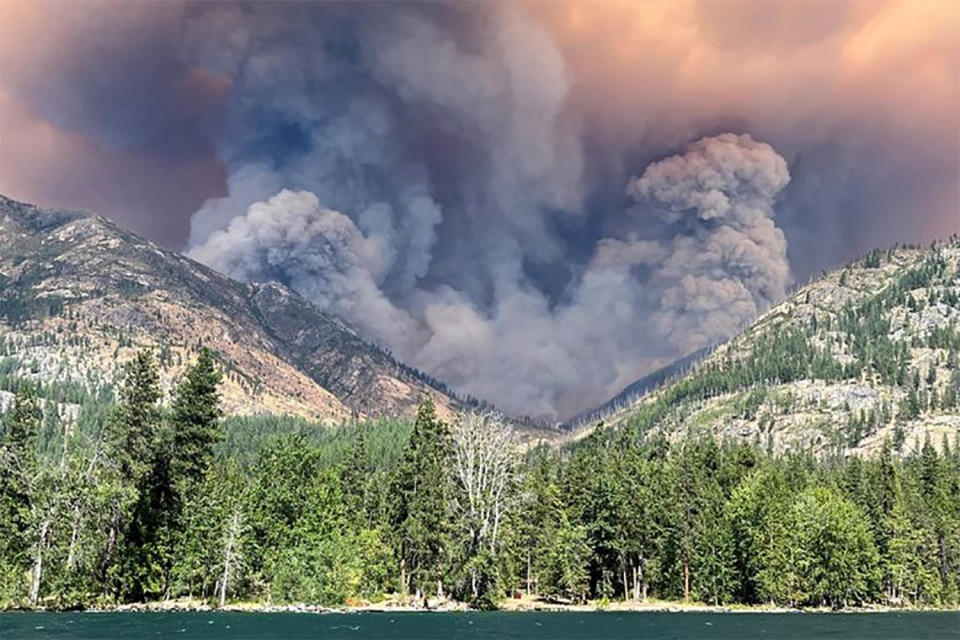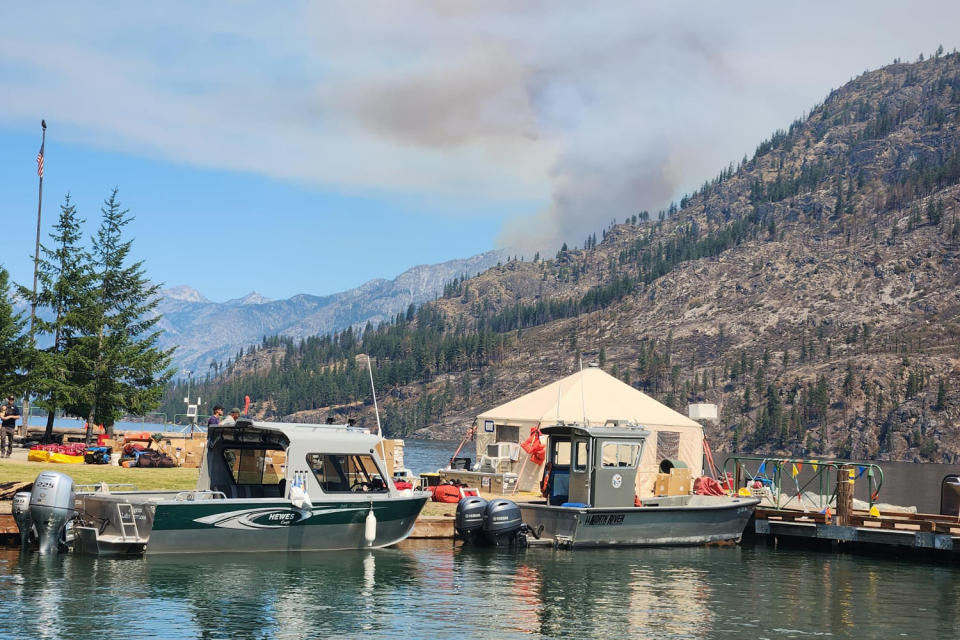SEATTLE — As the Pioneer Fire approached within a mile and a half of the remote town of Stehekin in northern Washington, emergency management officials went door-to-door Sunday asking residents to evacuate.
The evacuation warning has been raised to the highest level.
“The boats are running,” said Rich Magnussen, an emergency management specialist for Chelan County. “They’re running twice a day to try to get people out.”
There weren’t many takers. Most residents stayed in their homes, choosing to strengthen their defenses and provide support to firefighters rather than flee.
“We will do everything we can to get people out but we cannot give any guarantees due to the fire conditions,” Magnussen added.
Stehekin is a tight-knit community on the shores of Lake Chelan, a deep, 50-mile-long lake that meanders between the North Cascade Mountains, some of the most rugged terrain in the U.S. There are no roads connecting Stehekin to the rest of the state; the only quick exit is by helicopter or boat.
“We really need these people to get down and get out of danger,” Washington Governor Jay Inslee said in a statement. Video address on Xcalled on residents to evacuate.
But three days later, by Wednesday afternoon, Magnussen said, 90 of the 95 residents had decided to stay. Washington residents have the right to stay to protect their homes during the wildfire, Magnussen said.
Chelsea Courtney, a Stehekin resident and artist who works at the local bakery, chose to stay.
“There are a lot of really independent people here who are used to being extremely resourceful, who rely on their neighbors,” Courtney said. “People are passionate about this valley and the life they’ve built here, and I think we don’t fully trust the entities in terms of the management choices that are taking place.”
Courtney said Stehekin residents appreciate the efforts of firefighters but question why the fire wasn’t dealt with more aggressively when it started in June. He added that there have been occasional miscommunications between fire managers and residents, and he doesn’t understand why more wasn’t done in the colder months to help the forest adapt better to the changing climate.
Mistaya Johnston, a local health worker and farm facility owner, added: “There are a lot of people here who are not confident,” and in such a self-reliant society, when the stakes are so high, many people want to make it on their own.
“If our business burns down, we won’t be able to get paid anymore,” Johnston said.

Such feelings are common during high-stress wildfires in the rural West. As large, intense wildfires and evacuations become more common, some residents are growing tired of uprooting their lives and are becoming accustomed to the risk — or more confident in their ability to manage it on their own.
This means some people are determined to stay in their homes even when authorities say they should leave, especially when there is distrust between communities and those managing the bushfire and emergency response.
“We’re starting to see more people, especially in rural communities, decide to stay and defend,” said Amanda Stasiewicz, an assistant professor of environmental studies at the University of Oregon who studies evacuation decisions. “There’s a lot of distrust there.”
As fire behavior intensifies due to climate change and forest overgrowth, suspicions may arise in rural communities as fire managers become more conservative than in the past.
“People were used to fires attacking in different ways decades ago, and now there’s a different reality,” Stasiewicz said. “We’re now seeing fires behaving more radically, creating their own weather conditions and being more unpredictable.”
This dynamic is playing out in rural communities elsewhere, too.
Some Northern California residents whose homes were threatened by the Park Fire — currently more than 397,000 acres and the fourth-largest in state history as of Friday morning — have similarly decided not to evacuate, the San Francisco Chronicle reported. One couple told the Chronicle they decided against evacuating after having to wait 10 days to return to their home after the 2018 Camp Fire.
There are about 94 major fires burning in the West, with more than 29,000 wildfire firefighters working to put them out, according to the National Interagency Fire Center. Of those fires, 28 have active evacuation orders.
“When you get to a situation like this, everybody’s doing the best they can and their resources are stretched,” said Brad Bramlett, public information officer for the Pioneer Fire Department.
The Pacific Northwest, in particular, has been rocked this summer by about 51 major wildfires burning in Oregon, Washington and Idaho. A warmer and drier spring and summer than usual have primed the landscape for burning.
As of Friday morning, the Stehekin area was under a red flag warning for dangerous fire weather, according to the National Weather Service. The Pioneer fire had spread to more than 33,700 acres and was about 12% contained.
Most years the fire season would just be beginning.
Stehekin has a full-time population of about 85, and its residents revel in small-town living. The community resisted telephone service until the early 2000s.
Surrounded by glacier-capped peaks and the clear waters of Lake Chelan, the town’s population swells in the summer months when tourists take 2.5-hour ferry rides from Stehekin to reach trails in North Cascades National Park.
The Pioneer Fire began on June 8 and is slowly moving north. It is burning in some of the most challenging terrain firefighters have had to deal with in the United States: steep slopes, rocky outcrops and few trails.
“As soon as I heard that, we said, ‘Okay, let’s get started,'” Courtney said. “We all know how dry and early spring is. It felt like fire season was going to pick up.”
Courtney said Stehekin residents have been planning and preparing, clearing brush near homes, building a floating dock in the harbor and holding community meetings.
Tourists were forced to leave the area after emergency officials raised the evacuation level to 2 out of 3 on July 25.
Meanwhile, firefighters have flocked to Stehekin. More than 640 fire department personnel are battling the blaze, but not all are stationed in town. Johnston said he and his six-person crew are serving crews about 200 meals a day.
Emergency officials asked everyone in the town to leave on Sunday.
Magnussen said emergency management officials could not guarantee any assistance, especially if the boat dock, which he described as “the only way out”, was on fire.
“When they choose to stay, they do so at their own risk,” he said.
Courtney said she is aware of that, but she worries that leaving Stehekin now could mean she may not be able to return for weeks, or even longer. For now, she thinks her self-sufficient community, full of people who own boats and are used to working the land, is prepared to weather the fire.
Some previous close calls have also hardened her attitude toward fire. Courtney witnessed the 2015 Wolverine Fire, which burned more than 60,000 acres near Stehekin, and last month, she joined family and friends a few miles “down the lake” to save her uncle’s property after firefighters left.
“My tolerance has increased,” he said.
Stasiewicz said that based on her own focus groups, surveys and interviews, sentiments like Courtney’s are becoming more common in rural communities. Evictions often carry a heavy financial cost, she said, and some rural residents worry that their properties won’t be prioritized.
“Sometimes we see rural communities losing out compared to more developed areas. There’s a mentality of, ‘Maybe we should look after ourselves,'” Stasiewicz said.


He added that longer fire seasons with more frequent blazes are wearing people out.
“If I’m told to evacuate every summer and they all miss, it’s a ‘wolf is here’ effect,” Stasiewicz said. “You lose confidence in the experts saying you should evacuate.”
For authorities, these trends mean it’s becoming increasingly difficult to convince people to leave. At the same time, fire managers are dealing with more dramatic fire behavior, which could lead them to make more conservative decisions — like issuing more frequent and widespread evacuation warnings.
In Stehekin, residents and firefighters cut control lines along the eastern edge of town and installed irrigation systems fed by the lake.
Planes and helicopters are picking up water from Lake Chelan and dumping it on the fire.
Courtney said incident management teams rotate shifts, with the latest group being more communicative and proactive. They help feed firefighters every day at Stehekin Pastry Co.
Courtney said what lies ahead for Stehekin will depend on the severity of the fire, how strong the control lines are and whether winds can push the fire into the city.
But what if the fire reaches the city?
“I have access to a boat,” he said.
This article was originally published on NBCNews.com